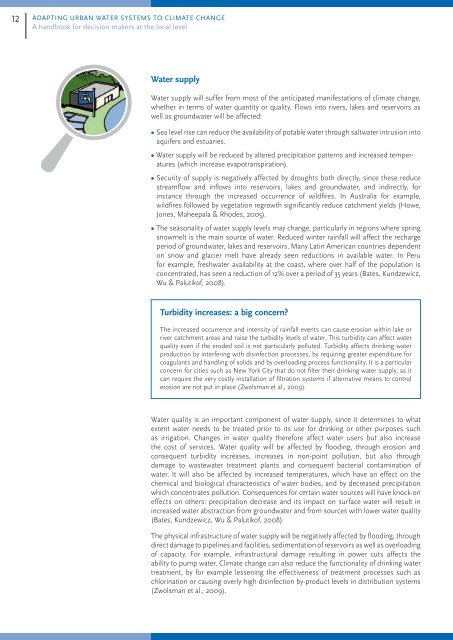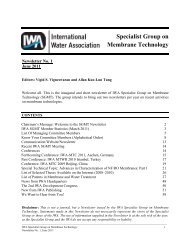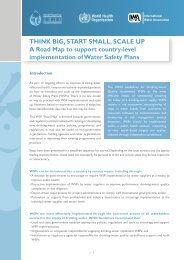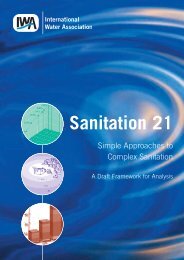AdApting urbAn wAter systems to climAte chAnge - IWA
AdApting urbAn wAter systems to climAte chAnge - IWA
AdApting urbAn wAter systems to climAte chAnge - IWA
You also want an ePaper? Increase the reach of your titles
YUMPU automatically turns print PDFs into web optimized ePapers that Google loves.
12 Adapting urban water <strong>systems</strong> <strong>to</strong> climate change<br />
A handbook for decision makers at the local level<br />
Section 1<br />
Vulnerability of urban water <strong>systems</strong> in the face of climate change<br />
13<br />
Water supply<br />
Water supply will suffer from most of the anticipated manifestations of climate change,<br />
whether in terms of water quantity or quality. Flows in<strong>to</strong> rivers, lakes and reservoirs as<br />
well as groundwater will be affected:<br />
• Sea level rise can reduce the availability of potable water through saltwater intrusion in<strong>to</strong><br />
aquifers and estuaries.<br />
• Water supply will be reduced by altered precipitation patterns and increased temperatures<br />
(which increase evapotranspiration).<br />
• Security of supply is negatively affected by droughts both directly, since these reduce<br />
streamflow and inflows in<strong>to</strong> reservoirs, lakes and groundwater, and indirectly, for<br />
instance through the increased occurrence of wildfires. In Australia for example,<br />
wildfires followed by vegetation regrowth significantly reduce catchment yields (Howe,<br />
Jones, Maheepala & Rhodes, 2005).<br />
• The seasonality of water supply levels may change, particularly in regions where spring<br />
snowmelt is the main source of water. Reduced winter rainfall will affect the recharge<br />
period of groundwater, lakes and reservoirs. Many Latin American countries dependent<br />
on snow and glacier melt have already seen reductions in available water. In Peru<br />
for example, freshwater availability at the coast, where over half of the population is<br />
concentrated, has seen a reduction of 12% over a period of 35 years (Bates, Kundzewicz,<br />
Wu & Palutikof, 2008).<br />
Turbidity increases: a big concern<br />
The increased occurrence and intensity of rainfall events can cause erosion within lake or<br />
river catchment areas and raise the turbidity levels of water. This turbidity can affect water<br />
quality even if the eroded soil is not particularly polluted. Turbidity affects drinking water<br />
production by interfering with disinfection processes, by requiring greater expenditure for<br />
coagulants and handling of solids and by overloading process functionality. It is a particular<br />
concern for cities such as New York City that do not filter their drinking water supply, as it<br />
can require the very costly installation of filtration <strong>systems</strong> if alternative means <strong>to</strong> control<br />
erosion are not put in place (Zwolsman et al., 2009).<br />
Water quality is an important component of water supply, since it determines <strong>to</strong> what<br />
extent water needs <strong>to</strong> be treated prior <strong>to</strong> its use for drinking or other purposes such<br />
as irrigation. Changes in water quality therefore affect water users but also increase<br />
the cost of services. Water quality will be affected by flooding, through erosion and<br />
consequent turbidity increases, increases in non-point pollution, but also through<br />
damage <strong>to</strong> wastewater treatment plants and consequent bacterial contamination of<br />
water. It will also be affected by increased temperatures, which have an effect on the<br />
chemical and biological characteristics of water bodies, and by decreased precipitation<br />
which concentrates pollution. Consequences for certain water sources will have knock-on<br />
effects on others: precipitation decrease and its impact on surface water will result in<br />
increased water abstraction from groundwater and from sources with lower water quality<br />
(Bates, Kundzewicz, Wu & Palutikof, 2008).<br />
The physical infrastructure of water supply will be negatively affected by flooding, through<br />
direct damage <strong>to</strong> pipelines and facilities, sedimentation of reservoirs as well as overloading<br />
of capacity. For example, infrastructural damage resulting in power cuts affects the<br />
ability <strong>to</strong> pump water. Climate change can also reduce the functionality of drinking water<br />
treatment, by for example lessening the effectiveness of treatment processes such as<br />
chlorination or causing overly high disinfection by-product levels in distribution <strong>systems</strong><br />
(Zwolsman et al., 2009).<br />
Functionality is affected by increased temperatures, which favour the proliferation of<br />
equipment-clogging algae and lead <strong>to</strong> greater expense for treatment <strong>to</strong> remove the taste<br />
and smell linked <strong>to</strong> bacterial and fungal growth. Unanticipated colder temperatures also<br />
affect functionality by freezing water in pipes which then leads <strong>to</strong> cracks and leaks, as<br />
happened in Ireland during the winter of 2010/2011. Pipes can also crack because of<br />
the drying of soils during drought conditions. Moreover, certain management decisions<br />
made as a response <strong>to</strong> climate change events can have consequences for water supply:<br />
for example, setting aside reservoir capacity as a flood absorption buffer can decrease<br />
drinking water availability.<br />
Water supplies will also be affected by climate change driven alterations in water demand.<br />
Increased temperatures will increase water demand for all consumptive uses – barring<br />
efficiency improvements – and might therefore lead <strong>to</strong> stronger competition for water<br />
resources or require the sourcing of alternative water supplies. Water use in New York<br />
City for example increases by 11 litres per degree centigrade once temperatures go above<br />
25°C (Pro<strong>to</strong>papas et al., as cited in Kundzewicz et al., 2007). A related point is that in<br />
the context of reduced water availability, meeting any existing minimum ecological flow<br />
requirements will become more challenging, and could put in<strong>to</strong> question drinking water<br />
production licence renewals (Zwolsman et al., 2009).<br />
Wastewater <strong>systems</strong><br />
Much like water supply, the integrity and functionality of wastewater treatment infrastructure<br />
will be affected by climate change. The infrastructure of collection lines and wastewater<br />
treatment, including outfalls, pipelines and tanks, can be physically damaged by<br />
coastal flooding linked <strong>to</strong> sea level rise and also by flooding caused by increased precipitation.<br />
The functionality of wastewater treatment can also be reduced by flooding: in the<br />
case of cities with combined sewer<br />
<strong>systems</strong>, heavy rainfall events can<br />
overwhelm wastewater treatment<br />
capacity, which usually results in increased<br />
overflows. Coastal flooding<br />
can increase the salinity of influent<br />
and thereby disrupt biological processes<br />
and potentially affect the reuse<br />
of treated wastewater. Extreme<br />
events can challenge wastewater<br />
treatment plants by diluting or concentrating<br />
inflows, in the case of<br />
floods or droughts respectively.<br />
© Anne-Claire Loftus<br />
Functionality is also impaired by increased temperatures: these can have both positive and<br />
negative consequences for wastewater treatment (Bates, Kundzewicz, Wu and Palutikof,<br />
2008). Higher temperatures coupled with reduced rainfall can lead <strong>to</strong> increased pipe<br />
breakage due <strong>to</strong> drying of soils as well as increased deterioration of pipes due <strong>to</strong> corrosion<br />
from hydrogen sulphide build-up (Zwolsman et al., 2009; Howe, Jones, Maheepala and<br />
Rhodes, 2005). Wastewater management can also be indirectly influenced, for example if<br />
increased temperatures affect the oxygen levels of receiving water bodies and therefore<br />
lead <strong>to</strong> more stringent wastewater treatment requirements in order <strong>to</strong> stabilise these<br />
levels so as not <strong>to</strong> endanger eco<strong>systems</strong>.
















